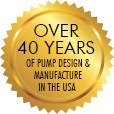High and Low Viscosity Liquids
The pumping action of the Hydra-Cell makes it a true positive displacement diaphragm pump at both high and low viscosities. Flow rate is independent of discharge pressure.
Typically, Hydra-Cell diaphragm pumps are used for liquids in viscosities ranging from 0.1 cps to 20,000 cps. Examples of these high and low viscosity liquids are solvents, hot water, turpentine, glues, resins and thick slurries.
Pumps with dynamic seals can ‘leak’ low viscosity liquids past a contact area of rotating surface and static casing, resulting in a loss of flow. Flow rate loss increases as pressure rises and, through time with increasing wear at the rotating contact surface. In the Hydra-Cell diaphragm pump, this declining performance cycle associated with low viscosity liquids does not occur because there are no dynamic seals in the design. Unlike many competing technologies, the Hydra-Cell diaphragm pump does not require lubricating fluids to prevent metal-to-metal contact and is capable of running dry indefinitely without damage.
When pumping high viscosity liquids, the horizontal spring-loaded, disk design of the Hydra-Cell check valves overcomes the “floating” issues associated with vertical ball-and-seat valves. Many high viscosity materials are shear sensitive. Hydra-Cell's horizontal check valves have proven to have a low shear pumping action not destroying the structure of shear sensitive high viscosity liquids.
See below for application examples from information supplied by customers.
The Hydra-Cell Advantage
- No dynamic seals
- True positive displacement pumping action
- Flow rate is virtually independent of operating pressure
- Pumping efficiency is sustainable long-term – not vulnerable to internal wear
- Pumps can handle non-lubricating liquids and liquids containing abrasive solids
- Low shear pumping action

